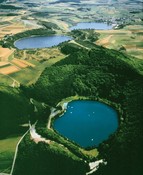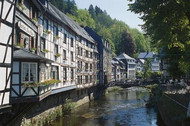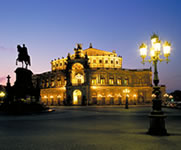
The Eifel has a host of rare treats in store for the visitor. These central highlands between Aachen, Cologne, Koblenz and Trier have retained the fresh beauty of their landscape, and that is exactly why they are so attractive. The region was shaped by volcanic activity in the Cenozoic period. When the mysterious and violent forces within the Earth pushed their way to the surface all those years ago, they emerged just where the Volcanic Eifel lies, leaving a dense network of maars (crater lakes), the Eifel's "blue eyes". Culturally speaking, this undulating upland has much to offer. Our Celtic and Roman predecessors have left their mark. The exquisite mosaics in the Roman villa near Otrang are one such reminder of Roman times. In the seventh and eighth centuries, the monasteries at Echternach and Prüm were founded and began disseminating religious, scientific and economic influence.
Although the region was once considered poor, with little more to offer than crater lakes, the modern era has gradually transformed the region. Yet what has remained unchanged is the austere beauty of its natural scenery and its core, the Volcanic Eifel – volcanoes that have been extinct for 10,000 years. Since most people find it hard to picture the history of the Earth, the Eifel volcano museum in Daun and the maar museum provide help visualising those dramatic events. High-tech computer simulations make volcanoes smoke again, open up the maars and send lava flows hissing and spitting towards the visitor. This truly is a spectacular experience.

It gets hot in Brockscheid, too. This is where the rare feat of bell founding has been taking place for five generations. In churches and cathedrals around the world, these bells now ring out to call the faithful to prayer. The mineral water extracted from the Eifel also travels around the world, as a refreshing, healthy drink.
This region is an enriching one in which to walk. Neatly kept villages, castles, palaces, abbeys, cliffs, lakes, waterfalls and over 500 sparkling mineral springs invite the visitor to experience sparkling fun. Many maars (water-filled volcanic craters) like Lake Laach are now very popular with watersports enthusiasts. The attractions of the region include the Eifel Lakes, with Europe's largest system of dams. The landscape of rolling hills and deep valleys is dominated by woodland and heaths. Here and there, untouched wetlands remain and provide habitats for amphibians. Isolated areas are home to rare plants and near-extinct animals.







